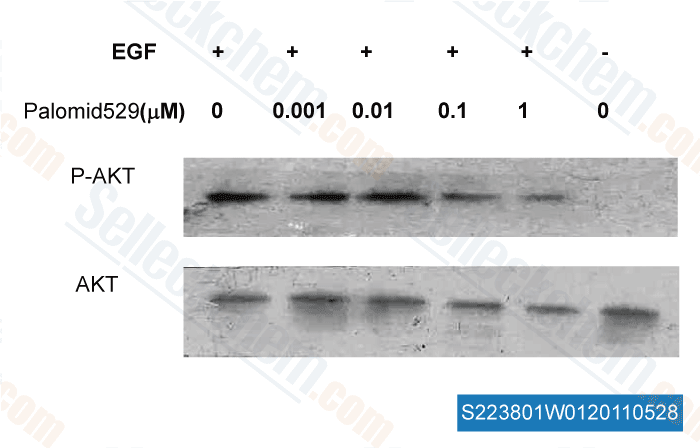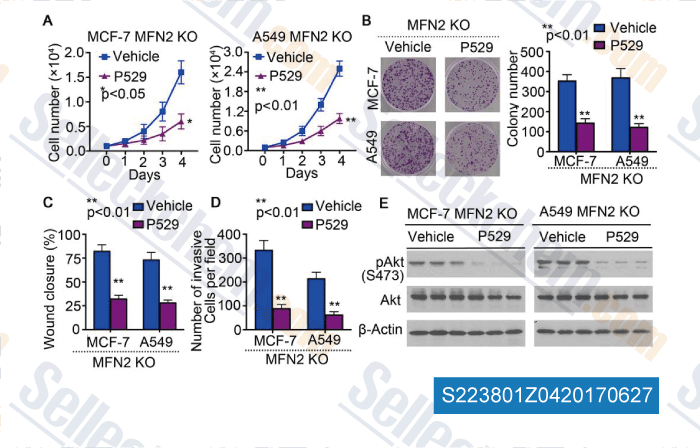|
Toll Free: (877) 796-6397 -- USA and Canada only -- |
Fax: +1-832-582-8590 Orders: +1-832-582-8158 |
Tech Support: +1-832-582-8158 Ext:3 Please provide your Order Number in the email. |
Technical Data
| Formula | C24H22O6 |
|||
| Molecular Weight | 406.43 | CAS No. | 914913-88-5 | |
| Solubility (25°C)* | In vitro | DMSO | 81 mg/mL (199.29 mM) | |
| Water | Insoluble | |||
| Ethanol | Insoluble | |||
|
* <1 mg/ml means slightly soluble or insoluble. * Please note that Selleck tests the solubility of all compounds in-house, and the actual solubility may differ slightly from published values. This is normal and is due to slight batch-to-batch variations. * Room temperature shipping (Stability testing shows this product can be shipped without any cooling measures.) |
||||
Preparing Stock Solutions
Biological Activity
| Description | Palomid 529 (P529, SG 00529) inhibits both the mTORC1 and mTORC2 complexes, reduces phosphorylation of pAktS473, pGSK3βS9, and pS6. Phase 1. | ||
|---|---|---|---|
| Targets |
|
||
| In vitro | Palomid 529 inhibits proliferation and increases apoptosis of endothelial cells. Palomid 529 inhibits both VEGF-driven and bFGF-driven endothelial cell proliferation with IC50 of 20 nM and 30 nM, respectively. Palomid 529 retains the ability to induce endothelial cell apoptosis. Palomid 529 decreases VEGF-A–driven phosphorylation of pAktS473, pGSK3βS9, and pS6. However, Palomid 529 prevents neither phosphorylated mitogen-activated protein kinase (pMAPK) nor pAktT308 as potently as pAktS473.[1] Palomid 529 not only reduces the proliferative response in the ischemic retina but also improves the organization and structure of the vessels that form. [1] Palomid 529 shows a potent antiproliferative activity in the NCI-60 cell lines panel, with growth inhibitory 50 (GI50) <35 μM. In addition, Palomid 529 significantly enhances the antiproliferative effect of radiation in prostate cancer cells (PC-3). Palomid 529 gives rise to a concentration dependent growth inhibition on PC-3 cells. Doses of 2 and 7μM resulted in 30 and 60% growth inhibition, respectively. Palomid 529 inhibits the radiation-induced p-Akt activation and decreases Bcl-2/Bax ratio in PC-3. Palomid 529 not only inhibits radiation-induced overexpression of Id-1 and VEGF but also down-regulates radiation-induced MMP-2 and MMP-9. [2] |
||
| In vivo | Palomid 529 shows a dose-dependent inhibition of the Ad-VEGF-A–driven angiogenesis following Palomid 529 treatment. Palomid 529 inhibits C6V10 glioma tumor growth in nude mice following i.p. dosing. Palomid 529 decreases AktS473 but not AktT308 signaling. Palomid 529 inhibits C6V10 glioma tumor growth in nude mice following i.p. dosing. Palomid 529 decreases AktS473 but not AktT308 signaling. Palomid 529 inhibits tumor growth, angiogenesis, and vascular permeability. [1] Treatment of PC-3 tumour-bearing mice with Palomid 529 reduced tumour growth to 57.1% compared with controls. [2] Palomid 529 is an effective suppressor of Müller cell proliferation, glial scar formation, and photoreceptor cell death in a rabbit model of retinal detachment (RD). [3] Palomid 529 significantly suppresses Brca1-deficient tumor growth in mice through inhibition of both Akt and mTOR signaling. [4] |
Protocol (from reference)
| Kinase Assay: |
|
|---|---|
| Cell Assay: |
|
References
Customer Product Validation

-
, , Dr. Zhang of Tianjin Medical University

-
Data from [Data independently produced by , , Sci Rep, 2017, 7:41718]
Selleck's Palomid 529 (P529) has been cited by 8 publications
| γ-catenin alleviates cardiac fibrosis through inhibiting phosphorylation of GSK-3β. [ J Biomed Res, 2020, 0(0):1-9] | PubMed: 31741464 |
| MFN2 suppresses cancer progression through inhibition of mTORC2/Akt signaling. [Xu K, et al. Sci Rep, 2017, 7:41718] | PubMed: 28176801 |
| A Mechanism for Asymmetric Cell Division Resulting in Proliferative Asynchronicity. [Dey-Guha I, et al. Mol Cancer Res, 2015, 13(2):223-30] | |
| A mechanism for asymmetric cell division resulting in proliferative asynchronicity. [ Mol Cancer Res, 2015, 13(2):223-30] | PubMed: 25582703 |
| Deciphering combinations of PI3K/AKT/mTOR pathway drugs augmenting anti-angiogenic efficacy in vivo [ PLoS One, 2014, 9(8):e105280] | PubMed: 25144531 |
| Deciphering Combinations of PI3K/AKT/mTOR Pathway Drugs Augmenting Anti-Angiogenic Efficacy In Vivo [Sasore T, et al PLoS One, 2014, 9(8):e105280] | PubMed: 25144531 |
| LKB1 Loss at Transcriptional Level Promotes Tumor Malignancy and Poor Patient Outcomes in Colorectal Cancer. [He TY, et al. Ann Surg Oncol, 2014, 10.1245/s10434-014-3824-1] | PubMed: 24879590 |
| Pharmacological profiling of phosphoinositide-3-kinase inhibitors as mitigators of ionizing radiation-induced cell death. [Lazo JS, et al. J Pharmacol Exp Ther, 2013, 347(3):669-80] | PubMed: 24068833 |
RETURN POLICY
Selleck Chemical’s Unconditional Return Policy ensures a smooth online shopping experience for our customers. If you are in any way unsatisfied with your purchase, you may return any item(s) within 7 days of receiving it. In the event of product quality issues, either protocol related or product related problems, you may return any item(s) within 365 days from the original purchase date. Please follow the instructions below when returning products.
SHIPPING AND STORAGE
Selleck products are transported at room temperature. If you receive the product at room temperature, please rest assured, the Selleck Quality Inspection Department has conducted experiments to verify that the normal temperature placement of one month will not affect the biological activity of powder products. After collecting, please store the product according to the requirements described in the datasheet. Most Selleck products are stable under the recommended conditions.
NOT FOR HUMAN, VETERINARY DIAGNOSTIC OR THERAPEUTIC USE.
